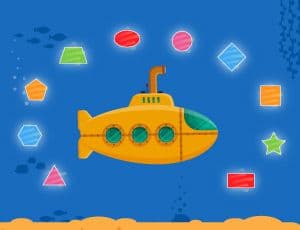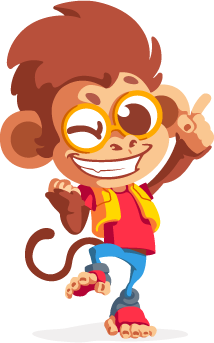Escola Games | Jogos Educativos
https://www.escolagames.com.br
Teacher's support sheet

Geometric Shapes
Come enjoy the under-the-sea adventure!
Click on the correct geometric shape and start piloting the yellow submarine! You can go up, down, to the front and back to get the shape of the level. This aquatic adventure will help you figure out geometric figures and other things.

Teacher's tips
Level of education: Elementary School
Age: 04 to 06 years old
Geometric shapes are everywhere, bringing with them notions of space and form. This game allows children to expand their knowledge and become familiar with flat geometric shapes, identifying their differences and similarities, awakening the need to observe space. At each round, the game highlights only one form, better fixing this content. [FIM-DICA]
Learner outcomes
Know the geometric shapes;
Improve visual discrimination ability;
Identify and name geometric shapes and relate them to the drawing;
Identify similarities and differences between geometric shapes;
Establish relationships between objects with a flat geometric figure, observing their characteristics;
Reinforce classroom content;
Stimulate creativity;
Develop motor skills;
Develop logical reasoning;
Teachers' goals
Working with flat geometric shapes;
Promote and encourage creativity;
Apply activities that develop children's logical reasoning;
Work hand-eye coordination with mouse skills;
Appreciate the visual arts.
Enable integration with people and environments.
Fix content worked in the classroom;
Suggestions of approaches for the teacher
(Suggestion 1) To introduce the subject of the game, talk to the children about the diversity of shapes of the objects around us, starting with the classroom: the blackboard, desks, chairs, door, clock, eraser, etc. .
Explore the various geometric figures and the name of each one.
(Suggestion 2) Propose the game in pairs, where members should take turns at each move. Check the FULL SCREEN option, so that the children can better visualize the images.
During the game, while a colleague is playing, the other makes a record on a sheet of paper: he draws the figure that is being captured and writes its name. This record is also an ally for memorizing geometric figures and their names.
(Suggestion 3) Make cutouts in magazines assembling geometric shapes;
(Suggestion 4) Draw shapes using objects, such as: circles using cups, squares using milk cartons, etc.
(Suggestion 5) Make a collage of grains inside the geometric shapes.
(Suggestion 6) Cut sponges to make stamps. Use these shapes by wetting them in paint and marking them on the cardboard.
(Suggestion 7) Build a panel of geometric shapes.
(Suggestion 8) Create a track with geometric shapes. The student receives a sequence that he must continue jumping on the corresponding geometric shapes. The student who reaches the finish line first by hitting the entire sequence wins.
(Suggestion 9) Use of logic blocks and LEGO.
(Suggestion 10) Promote activities to complete the symmetry of geometric figures using popsicle sticks and matches.
(Suggestion 11) Build a jigsaw puzzle of geometric shapes, then ask the students to classify them.
(Suggestion 12) Ask students to draw pictures of animals using only geometric shapes.
More about the content
Another enriching activity of this project is to take the students on a 'tour' around the school. During the tour they should observe everything around them, finding geometric shapes. The observation of shapes in various places is important to bring the content closer to the student's reality, giving greater meaning and motivating them.
An interesting proposal is also the version of “Dance of chairs”, but with geometric figures. Take the class to the court (or other available space in the school). Also take several geometric figures cut out of newspaper: circle, square, rectangle, triangle, trapeze, pentagon and others. It is important to have one less figure than the number of students in the class. Cut them out in large size (about half of a cardboard).
Arrange the figures on the court floor. You can stick them with a little piece of masking tape, if it's very windy.
Put on lively music and guide the children to walk between the figures. When the music stops, each child must step on a figure (be careful not to tear it). One student will be left out, as in “Dance of chairs”. This one comes out of the joke.
If you want, you can also propose that each one should say the name of the figure they chose to step on. If you don't know, get out of the game.
It is important to take a figure off the floor for each student who leaves.
During the activity, it is important to talk about the characteristics of the figures, their sides and corners, if they have sides, how many they are, if the sides are the same or different sizes and even the name of an object that resembles that shape.
The game ends when there is only one child left.
